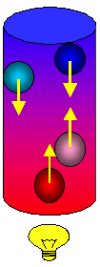
A Lava lamp

The base of lava lamps heats oil blobs submerged in a different liquid at the bottom of the lamp. Heating changes the density of the blobs and they rise towards the top of the lamp due to increasing Archimedes force. At the top of the lamp, which is slightly cooler, the blobs dissipate the heat, they become denser and begin to fall down.
The density of the oil blobs and the density of the liquid are chosen so that they are 'almost' equal. Since they do not mix, several competitive processes take place:
1. The liquid and the oil have slightly different coefficients of thermal expansion. The liquid has a smaller one, its density changes less than the density of the blobs. Thus, the blobs with rising temperature change their density much more than the liquid, so they get relatively lighter and drift upwards.
2. Specific heat capacity for two liquids which do not mix may differ, one liquid can be heated faster than the other. Water, whose specific heat capacity is 4200 J/kg×K, will heat at a slower pace compared to turpentine, whose specific heat capacity is 1800 J/kg·K.
JW Player goes here
|
JW Player goes here
|